_02-07.jpg) BUY IT AT AMAZON: CLICK HERE!
BUY IT AT AMAZON: CLICK HERE!
STUDIO: Warner Bros.
MSRP: $26.98
RATED: R
RUNNING TIME: 172 min.
SPECIAL FEATURES:
Disc 1
• Part One (113 min.)
• Commentary by director Philip Kaufman, screenwriter Jean-Claude Carriere, actress Lena Olin and editor Walter Murch
Disc 2
• Part Two (58 min.)
• Commentary, continued
• “Emotional History” Making-of
• Theatrical Trailer
It’s hard to believe, but 18 years ago American filmmakers weren’t shooting every third movie in Eastern Europe. These days, you want to make a movie set in the Czech Republic, or in Slovakia? You go to the Czech Republic, or Slovakia. Back then it was just Czechoslovakia, and there was this thing called the Soviet Union. It was a pretty big deal.
In 1986, though Gorbachev’s glasnost policies were helping to turn the tide of the Cold War, Milan Kundera’s 1984 novel was too hot for Czech state officials to allow. It was clear that this love letter to his homeland could not be filmed there. Who could have known that by the time the film was released in 1988 (having been shot in France, with Lyon doubling for Prague), the U.S.S.R. had only a year to live?
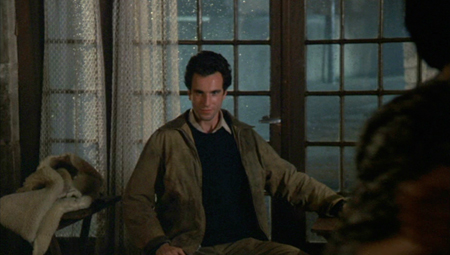
"Welcome back my friends, to the show that never ends."
The Flick
Tomas (Daniel Day-Lewis), a talented young neurosurgeon, has the world on a string—or would, if he believed in getting attached to anything. When he isn’t having wild sex with his best friend, the equally noncommittal Sabina (Lena Olin), he’s having wild sex with every other woman he meets, courtesy of a pick-up line only a handsome M.D. could get way with: “Take off your clothes.” Then shy little Tereza (Juliette Binoche) comes along… and Tomas loves her. Marries her. Stands by her when all hell breaks loose and she’s out taking pictures in the middle of it. He even gives up his career for her… and still has sex with all the ladies. Man’s gotta have priorities!
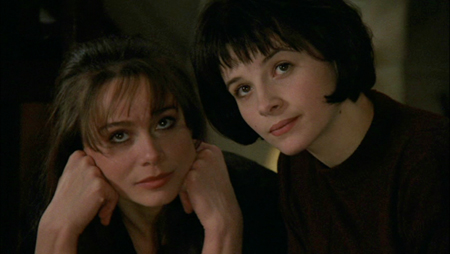
"We’re so glad you could attend. Move along, move along."
In the wrong hands, the story would be terribly superficial—a trite fable about an incorrigible womanizer transformed by true love. What the film manages to do is show the flip side: yes, Tomas is ruled by his passions; they bring great pleasure to him (and oh so many ladies), but they also make him a man of stubborn conviction. He will not do anything that is against his nature. When he is pressured to retract an unpopular comment he made in the past, he stands by his words as he stands by all of his actions, making a political statement in spite of himself.
See, it’s Prague, 1968. The “Prague Spring”, when the Czechoslovakian people, nominally subjects of the Soviet state since WWII, thought they had a real shot at creating a democracy of sorts within the Communist model. Not to give anything away, but you know how, that same year, the protesters in Berkeley were getting hit with tear gas and firehoses? Picture that, and add about 5000 big fucking tanks.
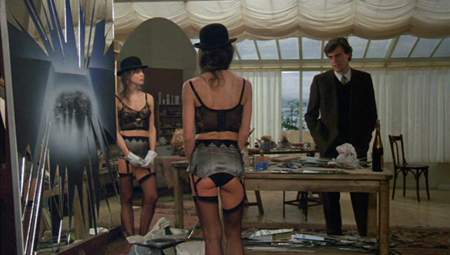
"Stunning! Awe-inspiring! I’ll take it! Oh, you mean the painting."
This brings us to the film’s tour-de-force, the invasion sequence. Again, cast your mind back to the realities of filmmaking in the mid-‘80s. No Forrest Gump digital jiggery-pokery here, this is the real shit: shots of the actors are intercut with bootlegged documentary footage of the actual events. Philip Kaufman had done a bit of this in The Right Stuff, but he and Walter Murch surpass themselves here.
A note on the actors. We’ve got an Anglo-Irishman, a Frenchwoman, and a Swede, all playing Czechoslovakians. In English, with Czech accents. That’s a lot of artifice for anyone to overcome, but honestly—nobody else could have played (let alone embodied) these roles.

That’s right, I said ’embodied’.
Besides, The Unbearable Lightness of Being isn’t just a recreation of a time and place, but of an aesthetic. The international casting works with the music, the settings, even the documentary-influenced camera movements, to remind us of the way European films from the late ‘60s feel. With this production Kaufman & co made the Ultimate Foreign Film, only in English. It’s also one of the sexiest movies ever.
I have to say though, the last half-hour doesn’t quite work for me. Tomas and Tereza, persecuted and oppressed everywhere they go, somehow end up in an idyllic farming community, where honest work and closeness to the earth restore their love. I know the resemblance to Tolstoy is intentional, and that Kundera resorted to such a fairy-tale scenario because he couldn’t envision an end to Soviet rule in the real world, but it still feels at odds with the rest of the film. The finale is magnificent, though.
9.5 out of 10
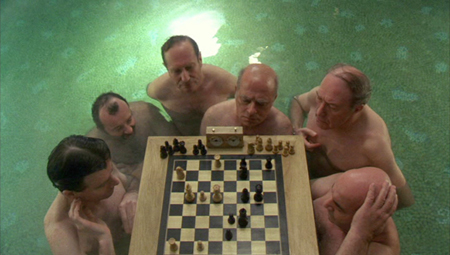
Some beefcake for you ladies out there.
The Look
This appears to be a new transfer, slightly side-masked to approximately 1.76:1 anamorphic. I was happy enough with the 1999 Criterion edition (also anamorphic); of course, it’s hard to make Sven Nykvist’s cinematography look bad. There has been some dust removal, the flesh tones are more saturated, and the general color tone has been shifted towards yellow. I personally prefer the colder palette of the Criterion, but I don’t know which choice best reflects the filmmakers’ intent. The Criterion DVD had some rather noisy shadow detail; this disc’s image is smoother overall, thanks to increased disc space and decreased edge-enhancement, though it seems a bit softer too.
8.5 out of 10

"Sit tight, ma’am. Your underwear is in here somewhere."
The Noise
Dolby 2.0. When your movie was originally mixed by an alchemist like Alan Splet, you honestly don’t need an ‘upgrade’. Besides, the two-channel mix fits the film’s retro style.
9 out of 10

"OK, just like we practiced. You go for his legs and I’ll throw the dog in his face."
The Goodies
The excellent commentary track from the Criterion disc has been carried over intact. It’s a little confusing because the speakers often refer to events taking place ten years ago when it’s now been more than fifteen, but it’s still well worth a listen. Murch’s deconstruction of the final scene is a perfect demonstration of the power of film editing.
The documentary is new, but doesn’t provide much additional information aside from a look at how the invasion sequence came together. I was hoping for some behind-the-scenes footage or some vintage interviews, but it’s all contemporary material.
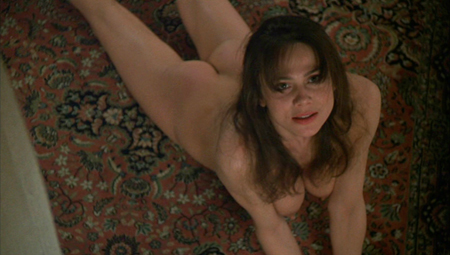
"Funny, but I always feel naked without my hat…"
Note: It isn’t mentioned anywhere on the packaging, but the movie has been split over two discs for this edition. The break-point is well chosen, though still a little jarring if you’re not expecting it.
7 out of 10
The Artwork
Crowded with text and awkwardly cropped. Pictures should be allowed to speak for themselves. Especially pictures of Lena Olin in that hat.
6 out of 10
